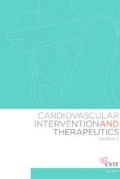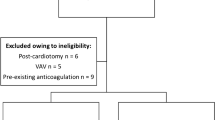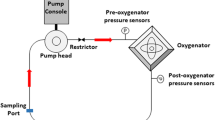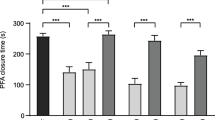Abstract
Veno-arterial extracorporeal membrane oxygenation (VA ECMO) is a powerful device for treatment of patients with life-threatening heart failure. Although bleeding is often associated with VA ECMO and sometimes results in a fatal outcome, its precise causes remain unknown. On the other hand, excessive high shear stress in the cardiovascular system causes acquired von Willebrand syndrome (aVWS), characterized by loss of von Willebrand factor (vWF) large multimers. vWF large multimers of five consecutive patients treated with VA ECMO were quantitatively evaluated using the vWF large multimer indices, defined as the ratio of the large multimer ratio of a patient to that of a healthy subject analyzed simultaneously. All 5 patients exhibited oozing type of bleeding at the skin insertion sites under treatment with PCPS at flow rates of 2.5–3.0 l/min/m2, including two severe cases of bleeding; one patient had massive gastrointestinal bleeding and another had hemothorax. Their vWF large multimer indices were 20.8, 28.8, 27.6, 51.0, and 31.0% (means 31.8 ± 11.4%). Surprisingly, these values are much lower than those observed in severe aortic stenosis reported previously by us (Tamura et al. in J Atheroscler Thromb 22:1115–1123, 2015), where vWF multimer indices in 31 severe aortic stenosis patients with peak pressure gradient through the aortic valves of 85.1 ± 29.4 mmHg were 75.0 ± 21.7% (p < 0.0001), indicating that much higher grade of aVWS occurred in patients with VA ECMO than severe aortic stenosis patients. All the 5 patients treated with VA ECMO developed aVWS that was much more severe than in patients with severe aortic stenosis.


Similar content being viewed by others
References
Tamura T, Horiuchi H, Imai M, Tada T, Shiomi H, Kuroda M, Nishimura S, Takahashi Y, Yoshikawa Y, Tsujimura A, Amano M, Hayama Y, Imamura S, Onishi N, Tamaki Y, Enomoto S, Miyake M, Kondo H, Kaitani K, Izumi C, Kimura T, Nakagawa Y. Unexpectedly high prevalence of acquired von Willebrand syndrome in patients with severe aortic stenosis as evaluated with a novel large multimer index. J Atheroscler Thromb. 2015;22:1115–23.
Nichol G, Karmy-Jones R, Salerno C, Cantore L, Becker L. Systematic review of percutaneous cardiopulmonary bypass for cardiac arrest or cardiogenic shock states. Resuscitation. 2006;70:381–94.
Hashiba K, Okuda J, Maejima N, Iwahashi N, Tsukahara K, Tahara Y, Hibi K, Kosuge M, Ebina T, Endo T, Umemura S, Kimura K. Percutaneous cardiopulmonary support in pulmonary embolism with cardiac arrest. Resuscitation. 2012;83:183–7.
Haberichter SL, Montgomery RR. Structure and function of von Willebrand factor. In: Marder VJ, Aird WC, Bennett JS, Schulman S, GWhite GC, editors. Hemostasis and thrombosis. 6th ed. Philadelphia: Lippincott Williams & Wilkins; 2013. p. 197–207.
Moake JL, Turner NA, Stathopoulos NA, Nolasco LH, Hellums JD. Involvement of large plasma von Willebrand factor (vWF) multimers and unusually large vWF forms derived from endothelial cells in shear stress-induced platelet aggregation. J Clin Investig. 1986;78:1456–61.
Sadler JE, Budde U, Eikenboom JC, Favaloro EJ, Hill FG, Holmberg L, Ingerslev J, Lee CA, Lillicrap D, Mannucci PM, Mazurier C, Meyer D, Nichols WL, Nishino M, Peake IR, Rodeghiero F, Schneppenheim R, Ruggeri ZM, Srivastava A, Montgomery RR, Federici AB, Working Party on von Willebrand Disease, C. Update on the pathophysiology and classification of von Willebrand disease: a report of the subcommittee on von Willebrand factor. J Thromb Haemost. 2006;4:2103–14.
Geisen U, Heilmann C, Beyersdorf F, Benk C, Berchtold-Herz M, Schlensak C, Budde U, Zieger B. Non-surgical bleeding in patients with ventricular assist devices could be explained by acquired von Willebrand disease. Eur J Cardiothorac Surg. 2008;33:679–84.
Meyer AL, Malehsa D, Bara C, Budde U, Slaughter MS, Haverich A, Strueber M. Acquired von Willebrand syndrome in patients with an axial flow left ventricular assist device. Circ Heart Fail. 2010;3:675–81.
Eckman PM, John R. Bleeding and thrombosis in patients with continuous-flow ventricular assist devices. Circulation. 2012;125:3038–47.
Meyer AL, Malehsa D, Budde U, Bara C, Haverich A, Strueber M. Acquired von Willebrand syndrome in patients with a centrifugal or axial continuous flow left ventricular assist device. JACC Heart Fail. 2014;2:141–5.
Amer S, Shah P, Hassan S. Gastrointestinal bleeding with continuous-flow left ventricular assist devices. Clin J Gastroenterol. 2015;8:63–7.
Kalbhenn J, Schmidt R, Nakamura L, Schelling J, Rosenfelder S, Zieger B. Early diagnosis of acquired von Willebrand Syndrome (AVWS) is elementary for clinical practice in patients treated with ECMO therapy. J Atheroscler Thromb. 2015;22:265–71.
Ruggeri ZM, Zimmerman TS. The complex multimeric composition of factor VIII/von Willebrand factor. Blood. 1981;57:1140–3.
Acknowledgements
This study was partly supported by a Health and Labour Sciences Research Grant for the ‘Research on rare and intractable diseases’ from the Ministry of Health, Labour and Welfare, Japan, to HH and YN, and grants from the SENSHIN Medical Research Foundation and the Suzuken Memorial Foundation to HH.
Funding
None.
Author information
Authors and Affiliations
Corresponding author
Ethics declarations
Conflict of interest
The authors declare that they have no conflict of interest.
Additional information
Publisher's Note
Springer Nature remains neutral with regard to jurisdictional claims in published maps and institutional affiliations.
Rights and permissions
About this article
Cite this article
Tamura, T., Horiuchi, H., Obayashi, Y. et al. Acquired von Willebrand syndrome in patients treated with veno-arterial extracorporeal membrane oxygenation. Cardiovasc Interv and Ther 34, 358–363 (2019). https://doi.org/10.1007/s12928-019-00568-y
Received:
Accepted:
Published:
Issue Date:
DOI: https://doi.org/10.1007/s12928-019-00568-y




